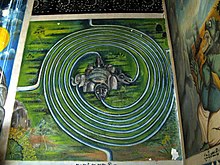Four corners of the world

Several cosmological and mythological systems portray four corners of the world or four quarters of the world corresponding approximately to the four points of the compass (or the two solstices and two equinoxes). At the center may lie a sacred mountain, garden, world tree, or other beginning-point of creation. Often four rivers run to the four corners of the world, and water or irrigate the four quadrants of Earth.
Ancient near eastern traditions
In Mesopotamian cosmology, four rivers flowing out of the garden of creation, which is the center of the world, define the four corners of the world.[1] From the point of view of the Akkadians, the northern geographical horizon was marked by Subartu, the west by Mar.tu, the east by Elam and the south by Sumer; later rulers of all of Mesopotamia, such as Cyrus, claimed among their titles LUGAL kib-ra-a-ti er-bé-et-tì, "King of the Four Corners".[2]

Semitic traditions
In Christianity and Judaism, the Old Testament (Book of Genesis, Genesis 2:8–14) identifies the Garden of Eden, and the four rivers as the Tigris, Euphrates, Pishon, and Gihon. The Tigris runs to Assyria, the Euphrates to Armenia, the Pishon to Havilah or Elam, and the Gihon to Ethiopia.[1][3][4] The four corners of the earth are also spoken of in the book of Revelation 7:1, and mention of the "four quarters of the earth" appears in Revelation 20:8.
Indian traditions
In
Another similar account from
See also
References
- ^ a b c George & George (2014) The Mythology of Eden, Rowman & Littlefield
- ^ "The Four Quarters of the World – Epiphany". Archived from the original on 2017-05-17. Retrieved 2017-04-15.
- ^
ISBN 9780827210776. Retrieved 2016-05-20.
The four rivers flowing out to the four corners of the world explain global geography as the ancients would have pictured it ([Genesis] 2:10-14).
- ^
ISBN 9781579102487. Retrieved 2016-05-20.
In a generally ignored but all-important paragraph of Genesis 2, we are told how the world was organized when it was created [...]. In short, the world was organized in terms of a primordial duality between the central sanctuary of Eden, and the outlying world watered by four rivers extending to the four corners of the world.
- ^ Jain cosmological map of adhaidvipa, Metropolitan Museum of Art, retrieved 2024-02-02
